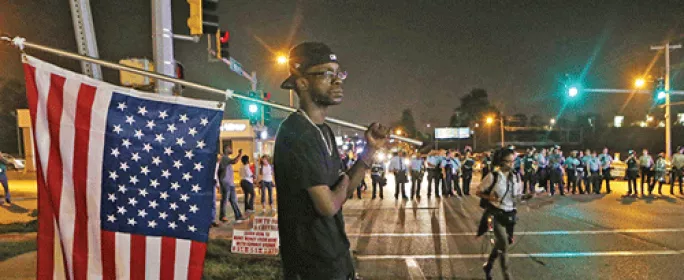‘There will be more Fergusons unless we tackle racial inequality in America’s suburban schools’
Gary Orfield, professor of education, law and political science, and co-director of the Civil Rights Project at the University of California, Los Angeles, writes:
The shooting of a young black man by a white policeman in Ferguson, Missouri has transfixed America. For days, little else was covered in our news channels. This case had such unambiguous racial dimensions that it created profound outrage. There were huge protests but no coherent demands to change the conditions of suburban resegregation.
This happened not in a classic city ghetto but in what had long been an almost all-white area. Is there any plan to address the educational and social decay? If we briefly immerse ourselves in the vivid images but then turn to other issues it will be for nothing. American media is very good at focusing on dramatic cases but not on the conditions that produce them. Our report warning last May that half the children in the suburbs of our large metros were nonwhite and increasingly segregated in bad schools, for example, did not make TV.
America is a suburban society. The great time of the big central cities was mid-20th century. Suburbs passed the central cities by 1970 and we became the first mostly suburban society by 1990. The commission that studied the great urban racial riots of the 1960s reported that the suburbs were 96 per cent white.
After that, however, the fair housing law and the spread of black and brown areas into suburbs changed the population, but the dominant result, especially in the schools, has been an expansion of segregation and inequality. Though the suburbs are the future of US society, deepening inequality and divisions have spread , with little public notice, in hundreds of school districts.
Ferguson is a diverse but internally segregated community which is resegregating.most rapidly in its schools. Private school enrollment is more than twice the national average, and a large share transfer to other school districts. The high school that Michael Brown attended is nearly all black, with low graduation rates, low test scores and a poor college-going record in the 97 per cent black Normandy school district. With schools like this there is little incentive for any middle class families to move in.
Our book, Resegregation of Suburban Schools, showed the remarkable changes. We looked at the suburbs of the 25 largest metro areas. Their 12 million suburban students accounted for one-fourth of all public school children in the US. These suburban regions now have about half nonwhite students. Most suburban rings are cut up into dozens of separate school districts, sometimes hundreds. After fair housing was enacted in 1968, black and Latino middle class followed the whites away from central cities and poor families of color came not long after. Planned efforts for “fair share” housing of the poor and drives for regional school integration plans were largely ended by the 1980s by the Reagan Administration and courts made conservative by new appointments. Housing discrimination fostered resegregation.
There are many different kinds of suburbs ranging from affluent largely white school districts to those experiencing rapid racial transition which have a very different fate. The most important things that influence school quality - students who are well-prepared from families with good educations and incomes and strong and experienced teachers - all tend to remain in stable integrated school but leave rapidly resegregating schools, greatly damaging school and community prospects. We commissioned case studies of suburban school districts across the country and found that few had plans to deal with racial change.
As the suburbs reflect more and more a country where half the students are nonwhite, we need new initiatives in civil rights and urban policy - issues that have been ignored in decades of control by anti-civil rights Republican administrations and the Obama administration. Lasting integration must be defined as the public goal. Threatened communities need enforcement against housing discrimination, with plans and help to successfully integrate their schools and staffs, and strategies making them continuously attractive though excellent educational programs in diverse schools. Regional strategies are very badly needed for both school and community integration. There are now many communities that are diverse and stable with far better outcomes.
The alternative to facing racial change positively and planning together - hard in an individualistic, localised and polarised society - will be communities dying separately as ghettos and barrios take hold in small communities even less able to deal with their challenges than the old central cities. We will see too many Fergusons.
Keep reading for just £1 per month
You've reached your limit of free articles this month. Subscribe for £1 per month for three months and get:
- Unlimited access to all Tes magazine content
- Exclusive subscriber-only stories
- Award-winning email newsletters




